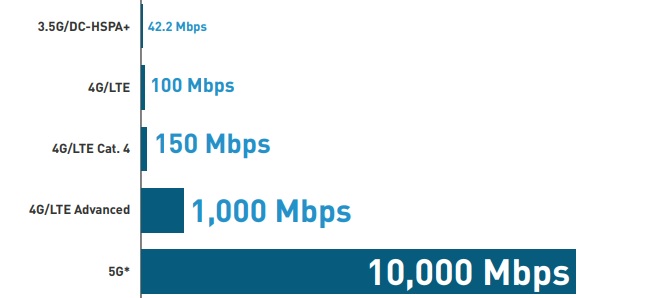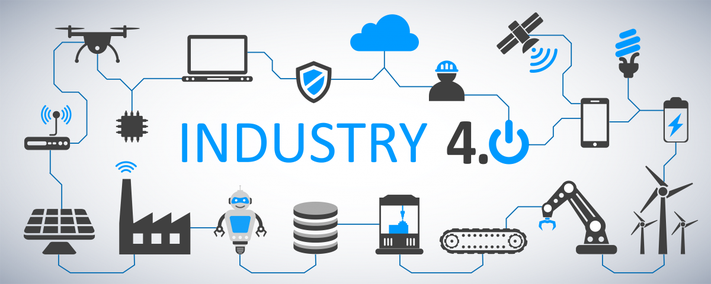Introduction
Over the past few years 5G has been a contentious topic. From health concerns, to great economic potential, to wild conspiracy theories, this technology has grasped the minds and imagination of many. But as an innovation that will underpin several other technologies and sectors, its impact has the possibility to be as substantial as it will be broad. Looking beyond the clickbait topics, if 5g is to be rolled out across a large part of the world in the near future, what are the likely social, technological, and economic benefits that will follow?
What Is 5G?
Anyone who has used a smartphone in the last several years will be familiar with the little 3G or 4G icon, indicating their wireless internet connection level and speed of transmitting or receiving data. Essentially each new ‘Generation’ increased the speed and size of data that could be sent. (For anyone wanting a slightly more technical breakdown I recommend this easy to read comparison).
Therefore, with each new generation more functionalities could be realised by the connected devices.

1G (1979) : Radio signal analog connections. Only voice was transmitted
2G (1991) : Digital signal. Enabled text, pictures, and multimedia messages
3G (2001) : Speeds up to 2 Mbps. Enabled large emails, Smartphones began using it
4G LTE (2009) : Truly enabled the app revolution, mobile video calls, e-commerce, and the digital revolution we are living in now. Eg. Uber and on demand businesses, Netflix and video streaming changing media consumption.
4G was a monumental technological leap costing an estimated $1 trillion in network upgrades between 2012 and 2018.
5G (2019) : A 10-100x increase in bandwidth! South Korea was the first country to adopt 5G on a large scale. 5G networks are predicted to have more than 1.7 billion subscribers worldwide by 2025, according to the GSM Association.
So 5G will enable wireless speeds that are an entire 1-2 orders of magnitude greater than what we experience today. What will be the outcome of this increase? How will industries be affected by this? Let’s look at two that may experience the greatest impacts.
What will 5G enable?
- Industry 4.0
The fundamental invention of the Watt Steam Engine enabled the first industrial revolution by allowing manufacturing to become geographically independent (moving from rivers and energy producing water wheels to urban areas factories). The social fallout was a population explosion that the world had never before experienced. Similarly in the second industrial revolution, electricity was implemented in factories for the first time allowing machines to be powered away from a central hub. This enabled assembly lines to be built and the birth of modern manufacturing capacities. Will 5G cause the same monumental socio-economic impacts as the steam engine, or electricity?
With these newfound speeds, wired connections can be replaced by wireless ones without any capability being sacrificed. This allows any previously stationary ‘plugged in’ setup to become highly agile and mobile, which is a key need for the current industrial era.. Thus 5G may be the main catalyst technology for Industry 4,0 to fully take off. A significant part of this is the ability to utilise autonomous machines which require large amounts of data to navigate safely and effectively across factories, that don’t have a fixed and easily mapped out floor plan anymore.
“Because this is wireless, production lines can be rearranged as needed. As a result, the areas that can be automated with AGVs and robots will increase, making it possible to improve work efficiency and reduce costs.” – Mitsubishi

Additionally, the increasing use of IoT devices that connect manufacturing machines to a potential centralised monitoring hub would be enabled to track and tweak machine performance to reach higher degrees of efficiency. These sensors can also be used for preventative maintenance, by estimating the breaking point of machines, servicing or replacing them before they cause slow downs or stoppages in a manufacturing line. This not only boosts overall success of any operation but also reduces the need for traditional human labour tasks and increases higher skill activities like monitoring and data analysis.
2. Healthcare
As with industry, 5G will transform the way that healthcare can be enacted. The same principle of greater data transmission that will enable autonomous factory activities with remote monitoring will be applied to healthcare. Remote healthcare or telemedicine is already something many of us have been dealing with during the Covid pandemic. But a powerful democratising aspect that 5G can bring about is remote surgeries. A glimpse into the future of healthcare occurred already back in 2019, where doctors in Beijing monitored robotic operations in three different geographical regions, over 100km away. Though the actions of the robots were pre-programmed the live video came in clear without any lag time, which is essential for real time surgery. Several other successful remote surgeries in China have been performed where the surgeon operated the robotic arms and blades in real time.
The reason this can be seen as a democratizing technology, is that even patients in rural areas would be able to be operated on by the best surgeons available. Geographical proximity, and transportation issues would no longer be a chokepoint for proper care.
The second major aspect that 5G can enable is a new connected healthcare ecosystem that truly aligns with ‘4P’ medicine: predictive, preventative, personalised, and participatory. As IoT sensors enable machines to have preventative maintenance, so too will we as patients be sharing our health data through the interaction of the plethora of devices we interact with. Fit bits, smartwatches, and smartrings, are but a few of the devices that are becoming more and more common to carry that track more and more of our realtime health data. As the number of these devices grow, and the number of people using them increases, healthcare providers will have a more robust understanding of individual traits, and needs and physical nuances. Therefore specific drugs or protocols can be prescribed for specific individuals, and even done before major symptoms arise, which is largely the opposite of how things are done today. This will largely take place outside of hospitals and health centres, but a similar improvement will happen inside. Patient beds, records, treatment devices etc can all be precisely tracked, and automatically assigned to their most efficient use, streamlining the healthcare system, leading to shorter wait times, fewer complications or mistakes, and ultimately leading to better individual patient care.

3. Other Industries
Apart from the main industries mentioned above, there are many others that will be heavily impacted like the energy sector, transportation, logistics, smart cities, and consumer media. Many of these will experience greater degrees of automation, but all will experience significant change, disruption, and have opportunities much like the first industrial revolutions. 5G technology is expected to create approximately $3.6 trillion in economic output and 22.3 million jobs by 2035 in the global 5G value chain alone.
If you want to read more about the impacts and opportunities some of the resources that informed this short blog post go into further detail:
- http://www3.weforum.org/docs/WEF_The_Impact_of_5G.pdf
- https://www.pwc.com/gx/en/about-pwc/contribution-to-debate/wef-the-impact-of-fiveg-report.pdf
- https://www.pwc.com/gx/en/tmt/5g/global-economic-impact-5g.pdf
Final Thoughts, What About 6G?
Even though we are only now starting to see the rollout of 5G and the potential impacts that it will have, this is not the final step. As with its predecessors, 5G will be replaced by 6G in the not so distant future.
In fact, on November 6, 2020 China successfully launched an experimental test satellite with candidates for 6G technology into orbit. The satellite is intended to “verify the terahertz (THz) communication technology in space” which will achieve data-transmissions speeds many times faster than what 5G is capable of. (possibly up to 1 Terrabye per second). Additionally. 5G devices can only transmit or receive one frequency at one time, but for 6G this wouldn’t be a problem, essentially you could send and receive on the same frequency.
What will this enable? One of the most exciting prospects of this is related to Virtual or Mixed Reality devices which need to process tremendous amounts of data on smaller devices to simultaneously deliver an experience and receive the interaction with that experience. The hardware wouldn’t need to do the processing anymore, rather the important element would be a 6G connection, to receive the computation done elsewhere and simply transmitted to the VR device. The same would be possible from autonomous cars, planes, boats. And most exciting, or terrifying of all, 6G would possibly have enough bandwidth and be fast enough to transmit sensory data to replicate real life environments. Essentially enabling brain computer interfacing to move from the realm of speculation and small demonstrations to practical, at scale use….





